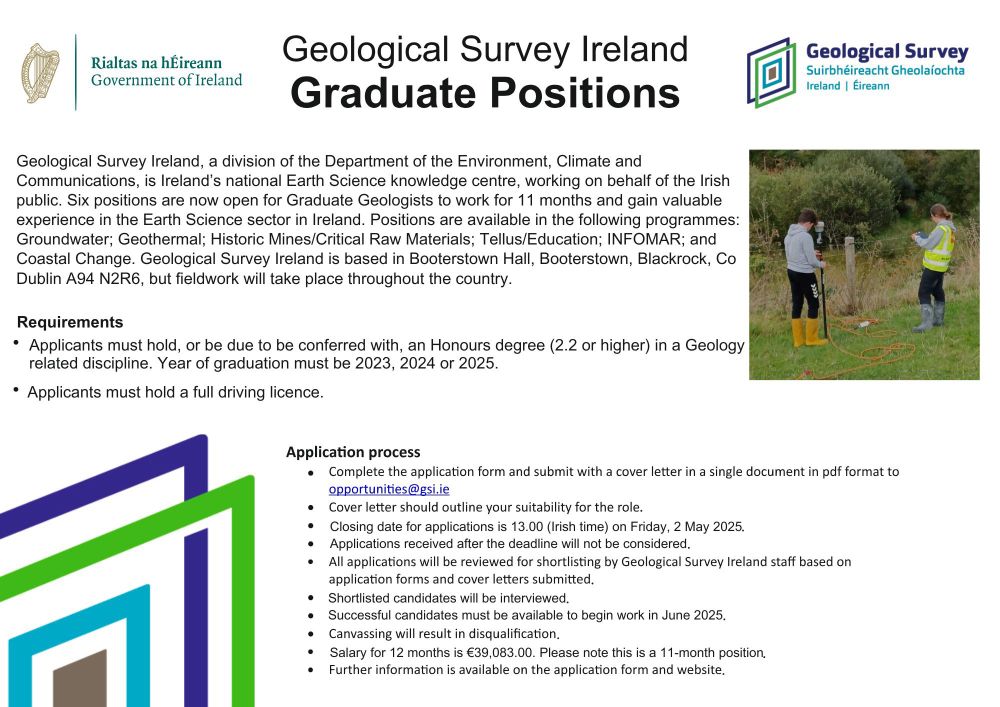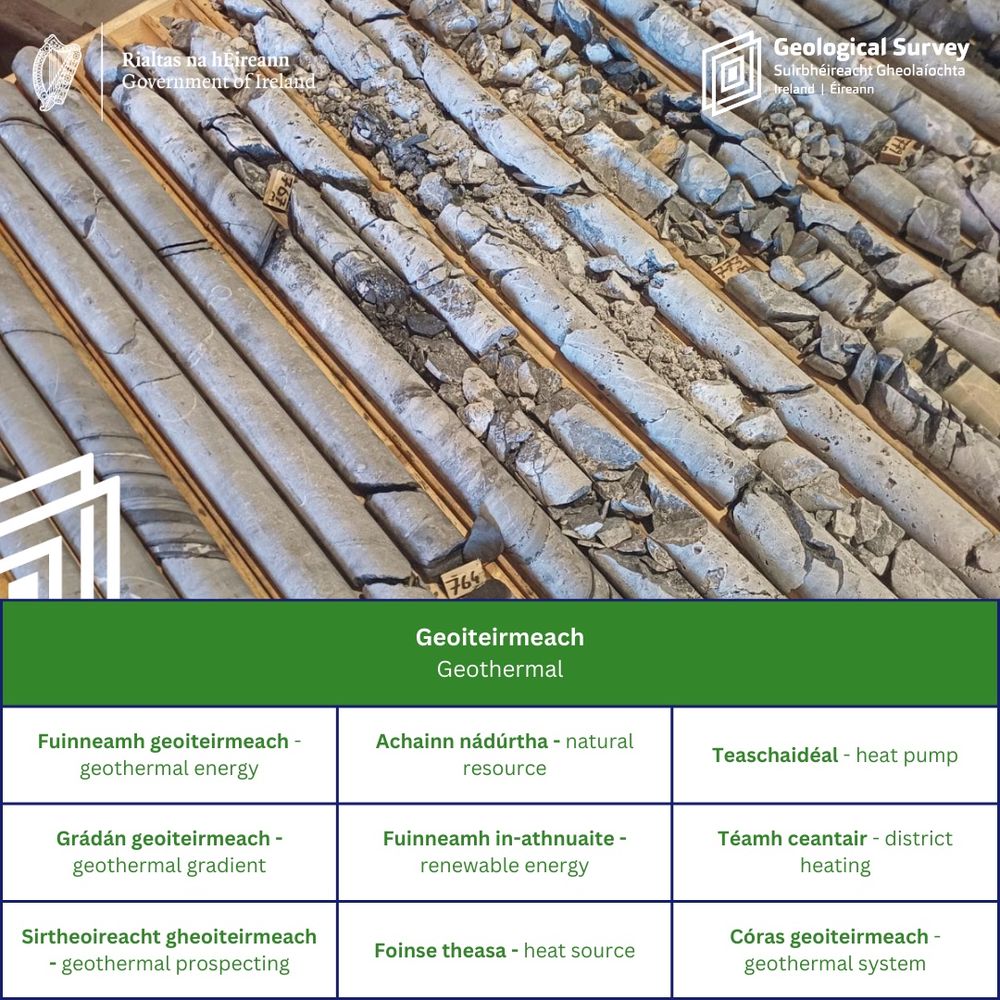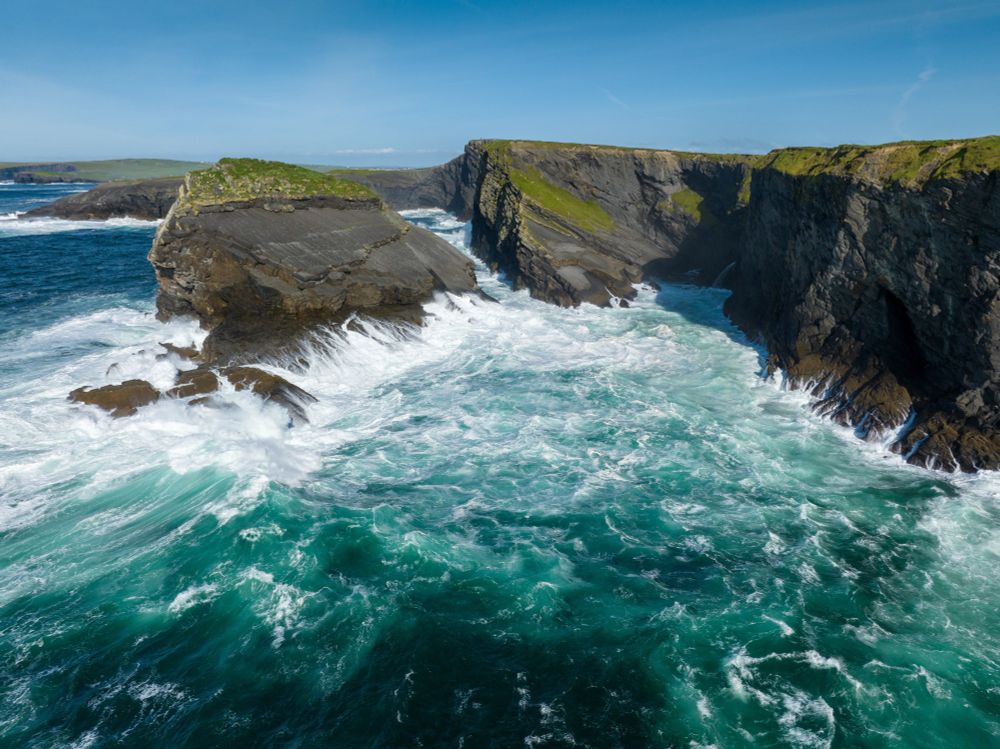
There are 6 Graduate Geologist positions, each of 11 months duration.
More info: www.gsi.ie

There are 6 Graduate Geologist positions, each of 11 months duration.
More info: www.gsi.ie
Visit our website for the application form and more information: www.gsi.ie/en-ie/events...

Visit our website for the application form and more information: www.gsi.ie/en-ie/events...
Murrens Esker formed by the deposition of sand and gravel by a subglacial river extending over 15km between counties Meath and Westmeath.
More information: www.gsi.ie


Murrens Esker formed by the deposition of sand and gravel by a subglacial river extending over 15km between counties Meath and Westmeath.
More information: www.gsi.ie
The sea stack is made of horizontal beds of Carboniferous mudstone, siltstone, and sandstone of the Central Clare Group.
Photo by: James Grandfield.

The sea stack is made of horizontal beds of Carboniferous mudstone, siltstone, and sandstone of the Central Clare Group.
Photo by: James Grandfield.
Our Activity Map for 2025 highlights the specific areas where we will be working. This includes the Tellus Programmes, INFOMAR sea-bed mapping carried out by the Survey, and mapping the south-east.
View the map here: www.gsi.ie

Our Activity Map for 2025 highlights the specific areas where we will be working. This includes the Tellus Programmes, INFOMAR sea-bed mapping carried out by the Survey, and mapping the south-east.
View the map here: www.gsi.ie
I s é téama an lae inniu ná an Ceathartha. 🏔️

I s é téama an lae inniu ná an Ceathartha. 🏔️
Is é téama an lae inniu ná guaiseacha geolaíochta🌍
Ba geoifisceoir Éireannach é Robert Mallet & bunatheoir na seismeolaíocht a thugtar air.

Is é téama an lae inniu ná guaiseacha geolaíochta🌍
Ba geoifisceoir Éireannach é Robert Mallet & bunatheoir na seismeolaíocht a thugtar air.
Is é téama an lae inniu ná geoiteirmeach. ♨️

Is é téama an lae inniu ná geoiteirmeach. ♨️
@quakeshake.bsky.social, will be giving a lecture titled “Fin Whale Song in Seismic Land Data: New Opportunities for Coastal Cetacean Monitoring”.
More info: www.gsi.ie/en-ie/events...

@quakeshake.bsky.social, will be giving a lecture titled “Fin Whale Song in Seismic Land Data: New Opportunities for Coastal Cetacean Monitoring”.
More info: www.gsi.ie/en-ie/events...
This hydrological feature is thought to date from between 1680 to 1720 and was significant to the development of Dublin as it supplied freshwater to local residents.


This hydrological feature is thought to date from between 1680 to 1720 and was significant to the development of Dublin as it supplied freshwater to local residents.
Is é téama an lae inniu ná mianraí. 💎

Is é téama an lae inniu ná mianraí. 💎
This image includes some of our staff who empower, inspire, and encourage others by attending outreach events, engaging with the public, and offering support to others within the Survey.

This image includes some of our staff who empower, inspire, and encourage others by attending outreach events, engaging with the public, and offering support to others within the Survey.
Is é téarma an lae inniu ná bruthcarraigeacha. 🌋

Is é téarma an lae inniu ná bruthcarraigeacha. 🌋
A number of Geological Survey Ireland staff presented on the research happening in the Survey, including the Tellus Programme, GEMINI, and the Research Programme.




A number of Geological Survey Ireland staff presented on the research happening in the Survey, including the Tellus Programme, GEMINI, and the Research Programme.
Hags Head is composed of horizontal to sub-horizontal beds of Carboniferous mudstone, sil stone, and sandstone of the Central Clare Group.
Photo by: Denis Ryan.

Hags Head is composed of horizontal to sub-horizontal beds of Carboniferous mudstone, sil stone, and sandstone of the Central Clare Group.
Photo by: Denis Ryan.
Chun an tseachtain a cheiliúradh tá Suirbhéireacht Gheolaíochta Éireann ag postáil an t-aistriúchán Gaeilge ar théarmaíocht na Geolaíochta.
Is é carraig dhríodair an téarma inniu.

Chun an tseachtain a cheiliúradh tá Suirbhéireacht Gheolaíochta Éireann ag postáil an t-aistriúchán Gaeilge ar théarmaíocht na Geolaíochta.
Is é carraig dhríodair an téarma inniu.
The full Press Release can be viewed on our website: www.gsi.ie

The full Press Release can be viewed on our website: www.gsi.ie
The glacial lake (tarn) formed when a glacier melted & retreated filling a corrie with water. 💚💚💚


The glacial lake (tarn) formed when a glacier melted & retreated filling a corrie with water. 💚💚💚
Discover what the colours on the #geophysics maps reveal on our website: www.gsi.ie

Discover what the colours on the #geophysics maps reveal on our website: www.gsi.ie
This is where the two old continents of Laurentia and Avalonia meet at the Iapetus suture, the line along which the Iapetus Ocean closed in the Silurian, over 400 million years ago.


This is where the two old continents of Laurentia and Avalonia meet at the Iapetus suture, the line along which the Iapetus Ocean closed in the Silurian, over 400 million years ago.
The cliffs are made of gently dipping beds of Carboniferous mudstone, siltstone, and sandstone of the Central Clare Group.
Photo by: Michael Gavin

The cliffs are made of gently dipping beds of Carboniferous mudstone, siltstone, and sandstone of the Central Clare Group.
Photo by: Michael Gavin
More info: www.gsi.ie



More info: www.gsi.ie
⚫️🟡
The cave formed when glacial meltwater (last 2.6 million years) chemically dissolved the permeable Carboniferous limestone (359 – 323 million years old) and resulted in impressive stalactites and stalactites.


⚫️🟡
The cave formed when glacial meltwater (last 2.6 million years) chemically dissolved the permeable Carboniferous limestone (359 – 323 million years old) and resulted in impressive stalactites and stalactites.




We have had a brilliant time so far discussing all things geoscience related.
Come visit our stand today in Hall 1.

We have had a brilliant time so far discussing all things geoscience related.
Come visit our stand today in Hall 1.

